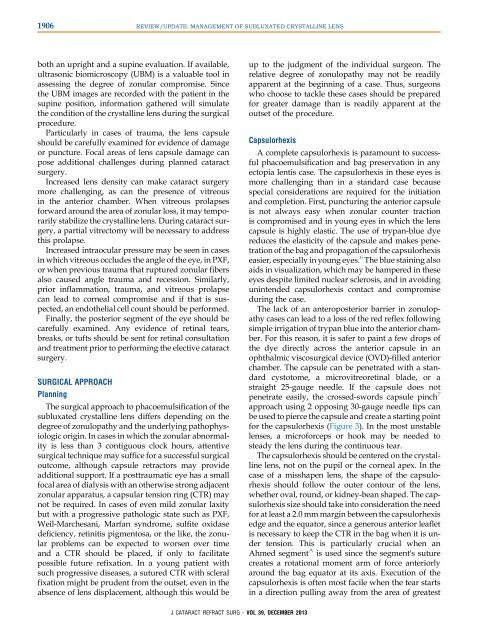Management of Subluxated Lens
Management of Subluxated Lens
Management of Subluxated Lens
Create successful ePaper yourself
Turn your PDF publications into a flip-book with our unique Google optimized e-Paper software.
1906 REVIEW/UPDATE: MANAGEMENT OF SUBLUXATED CRYSTALLINE LENS<br />
both an upright and a supine evaluation. If available,<br />
ultrasonic biomicroscopy (UBM) is a valuable tool in<br />
assessing the degree <strong>of</strong> zonular compromise. Since<br />
the UBM images are recorded with the patient in the<br />
supine position, information gathered will simulate<br />
the condition <strong>of</strong> the crystalline lens during the surgical<br />
procedure.<br />
Particularly in cases <strong>of</strong> trauma, the lens capsule<br />
should be carefully examined for evidence <strong>of</strong> damage<br />
or puncture. Focal areas <strong>of</strong> lens capsule damage can<br />
pose additional challenges during planned cataract<br />
surgery.<br />
Increased lens density can make cataract surgery<br />
more challenging, as can the presence <strong>of</strong> vitreous<br />
in the anterior chamber. When vitreous prolapses<br />
forward around the area <strong>of</strong> zonular loss, it may temporarily<br />
stabilize the crystalline lens. During cataract surgery,<br />
a partial vitrectomy will be necessary to address<br />
this prolapse.<br />
Increased intraocular pressure may be seen in cases<br />
in which vitreous occludes the angle <strong>of</strong> the eye, in PXF,<br />
or when previous trauma that ruptured zonular fibers<br />
also caused angle trauma and recession. Similarly,<br />
prior inflammation, trauma, and vitreous prolapse<br />
can lead to corneal compromise and if that is suspected,<br />
an endothelial cell count should be performed.<br />
Finally, the posterior segment <strong>of</strong> the eye should be<br />
carefully examined. Any evidence <strong>of</strong> retinal tears,<br />
breaks, or tufts should be sent for retinal consultation<br />
and treatment prior to performing the elective cataract<br />
surgery.<br />
SURGICAL APPROACH<br />
Planning<br />
The surgical approach to phacoemulsification <strong>of</strong> the<br />
subluxated crystalline lens differs depending on the<br />
degree <strong>of</strong> zonulopathy and the underlying pathophysiologic<br />
origin. In cases in which the zonular abnormality<br />
is less than 3 contiguous clock hours, attentive<br />
surgical technique may suffice for a successful surgical<br />
outcome, although capsule retractors may provide<br />
additional support. If a posttraumatic eye has a small<br />
focal area <strong>of</strong> dialysis with an otherwise strong adjacent<br />
zonular apparatus, a capsular tension ring (CTR) may<br />
not be required. In cases <strong>of</strong> even mild zonular laxity<br />
but with a progressive pathologic state such as PXF,<br />
Weil-Marchesani, Marfan syndrome, sulfite oxidase<br />
deficiency, retinitis pigmentosa, or the like, the zonular<br />
problems can be expected to worsen over time<br />
and a CTR should be placed, if only to facilitate<br />
possible future refixation. In a young patient with<br />
such progressive diseases, a sutured CTR with scleral<br />
fixation might be prudent from the outset, even in the<br />
absence <strong>of</strong> lens displacement, although this would be<br />
up to the judgment <strong>of</strong> the individual surgeon. The<br />
relative degree <strong>of</strong> zonulopathy may not be readily<br />
apparent at the beginning <strong>of</strong> a case. Thus, surgeons<br />
who choose to tackle these cases should be prepared<br />
for greater damage than is readily apparent at the<br />
outset <strong>of</strong> the procedure.<br />
Capsulorhexis<br />
A complete capsulorhexis is paramount to successful<br />
phacoemulsification and bag preservation in any<br />
ectopia lentis case. The capsulorhexis in these eyes is<br />
more challenging than in a standard case because<br />
special considerations are required for the initiation<br />
and completion. First, puncturing the anterior capsule<br />
is not always easy when zonular counter traction<br />
is compromised and in young eyes in which the lens<br />
capsule is highly elastic. The use <strong>of</strong> trypan-blue dye<br />
reduces the elasticity <strong>of</strong> the capsule and makes penetration<br />
<strong>of</strong> the bag and propagation <strong>of</strong> the capsulorhexis<br />
easier, especially in young eyes. 6 The blue staining also<br />
aids in visualization, which may be hampered in these<br />
eyes despite limited nuclear sclerosis, and in avoiding<br />
unintended capsulorhexis contact and compromise<br />
during the case.<br />
The lack <strong>of</strong> an anteroposterior barrier in zonulopathy<br />
cases can lead to a loss <strong>of</strong> the red reflex following<br />
simple irrigation <strong>of</strong> trypan blue into the anterior chamber.<br />
For this reason, it is safer to paint a few drops <strong>of</strong><br />
the dye directly across the anterior capsule in an<br />
ophthalmic viscosurgical device (OVD)-filled anterior<br />
chamber. The capsule can be penetrated with a standard<br />
cystotome, a microvitreoretinal blade, or a<br />
straight 25-gauge needle. If the capsule does not<br />
penetrate easily, the crossed-swords capsule pinch 7<br />
approach using 2 opposing 30-gauge needle tips can<br />
be used to pierce the capsule and create a starting point<br />
for the capsulorhexis (Figure 3). In the most unstable<br />
lenses, a micr<strong>of</strong>orceps or hook may be needed to<br />
steady the lens during the continuous tear.<br />
The capsulorhexis should be centered on the crystalline<br />
lens, not on the pupil or the corneal apex. In the<br />
case <strong>of</strong> a misshapen lens, the shape <strong>of</strong> the capsulorhexis<br />
should follow the outer contour <strong>of</strong> the lens,<br />
whether oval, round, or kidney-bean shaped. The capsulorhexis<br />
size should take into consideration the need<br />
for at least a 2.0 mm margin between the capsulorhexis<br />
edge and the equator, since a generous anterior leaflet<br />
is necessary to keep the CTR in the bag when it is under<br />
tension. This is particularly crucial when an<br />
Ahmed segment A is used since the segment's suture<br />
creates a rotational moment arm <strong>of</strong> force anteriorly<br />
around the bag equator at its axis. Execution <strong>of</strong> the<br />
capsulorhexis is <strong>of</strong>ten most facile when the tear starts<br />
in a direction pulling away from the area <strong>of</strong> greatest<br />
J CATARACT REFRACT SURG - VOL 39, DECEMBER 2013


